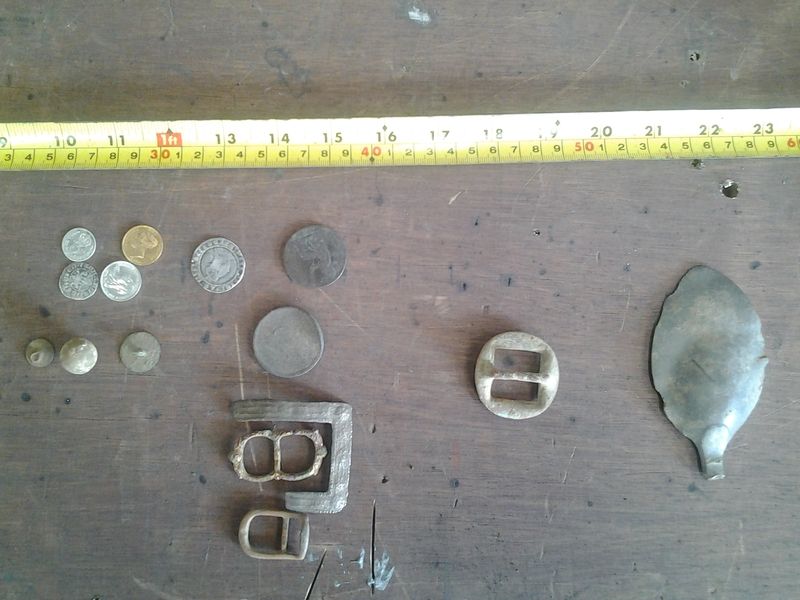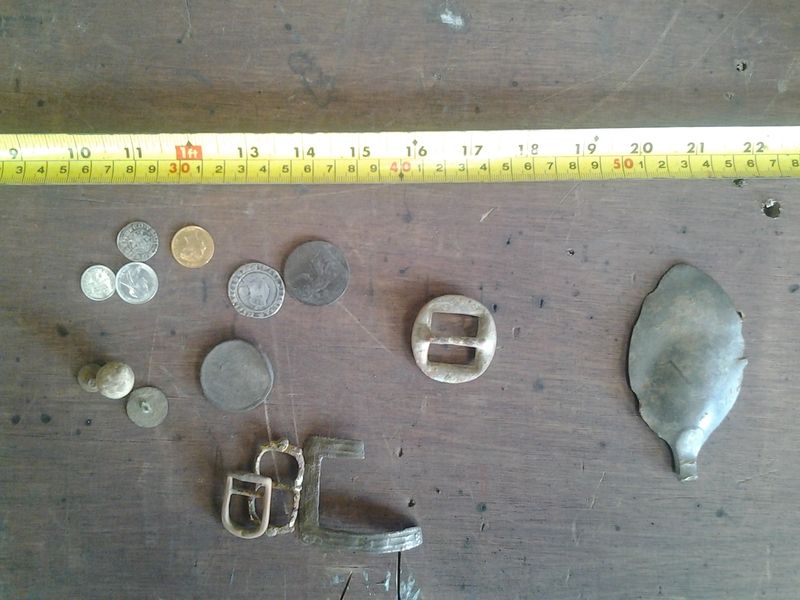Find's Treasure Forums
Welcome to Find's Treasure Forums, Guests!
You are viewing this forums as a guest which limits you to read only status.
Only registered members may post stories, questions, classifieds, reply to other posts, contact other members using built in messaging and use many other features found on these forums.
Why not register and join us today? It's free! (We don't share your email addresses with anyone.) We keep email addresses of our users to protect them and others from bad people posting things they shouldn't.
Click here to register!
Need Support Help?
Cannot log in?, click here to have new password emailed to you
You are using an out of date browser. It may not display this or other websites correctly.
You should upgrade or use an alternative browser.
You should upgrade or use an alternative browser.
metal detector frequency and how it affects finds ?
- Thread starter dfmike
- Start date
Certain frequencies are supposed to be partial to certain metals. They very well may be. I personally believe that no matter the frequency if your coil is over it you're going to pick it up. However, the different frequencies might have more of a positive effect on certain soils and soil conditions.
If you're at all concerned with it, get a multi freq detector.
If you're at all concerned with it, get a multi freq detector.
bootyhoundpa
Well-known member
General theory is high frequency is better at finding low conductors such as lead and gold... low frequently is better at finding high conductors such as copper and silver... i would be more concerned with target separation than frequency. .. i have found more gold with my whites 6.59 frequency 5900di pro than any of my other detectors. .. when it comes to saltwater multi frequency is necessary for best results...
REVIER
Well-known member
I never careed about this at all being an all around hunter.
I have found way more than my share of gold with an under 6kHz unit and silver with higher 14kHz units.
If I specialized in any area, gold nugget hunting or only combing old sites for the deepest silver I would think differently but I have found more than I ever thought possible at a decent range of depths in both good and bad soil under many conditions with all of them so for me a non issue.
Nice to have a choice, though, and I see more multi frequency units seem to be coming on board now without needing to switch coils like the soon to come Nokta Impact with it appears to be selectable choices of 5,14 or 20kHz and who knows...maybe a new Fisher that might do this soon to come or others.
Might be the wave of the future.
I have found way more than my share of gold with an under 6kHz unit and silver with higher 14kHz units.
If I specialized in any area, gold nugget hunting or only combing old sites for the deepest silver I would think differently but I have found more than I ever thought possible at a decent range of depths in both good and bad soil under many conditions with all of them so for me a non issue.
Nice to have a choice, though, and I see more multi frequency units seem to be coming on board now without needing to switch coils like the soon to come Nokta Impact with it appears to be selectable choices of 5,14 or 20kHz and who knows...maybe a new Fisher that might do this soon to come or others.
Might be the wave of the future.
Mike Hillis
Well-known member
That is kind of a mini book request, Mike.
I'd suggest reading the DFX operating manual and the V3i Advanced book.
Frequency affects phase response and phase response affects both ground cancelling and target discrimination.
I have too much in my head to put it out in a simple manner. But the reading I suggested will help start you in the right direction.
HH
Mike
I'd suggest reading the DFX operating manual and the V3i Advanced book.
Frequency affects phase response and phase response affects both ground cancelling and target discrimination.
I have too much in my head to put it out in a simple manner. But the reading I suggested will help start you in the right direction.
HH
Mike
still looking 52
Well-known member
dfmike, the two main reasons I like the f5 multi frequency is to cut out EMI and also when hunting with other machines around close to you, you can cut down on detector interference. Personally I don't think it affects what you find that much at all.
dfmike
Well-known member
Mike Hillis said:That is kind of a mini book request, Mike.
I'd suggest reading the DFX operating manual and the V3i Advanced book.
Frequency affects phase response and phase response affects both ground cancelling and target discrimination.
I have too much in my head to put it out in a simple manner. But the reading I suggested will help start you in the right direction.
HH
Mike
Thanks Mike I will try to find those manuals. They should be available online I suppose. I was indeed looking for a scientific explanation possibly from a designer, engineer perspective. I know the very basic theory that some have pointed out here but I'd like to know more.
Thanks to all for the information.
dfmike
Well-known member
still looking 52 said:dfmike, the two main reasons I like the f5 multi frequency is to cut out EMI and also when hunting with other machines around close to you, you can cut down on detector interference. Personally I don't think it affects what you find that much at all.
I use that a lot on the F5 to cut down on EMI at times. What I meant by my original post was more about the differences between detector main frequency like 5.9, 7.8, 13, 19 kHz and higher.
M&M's
op's did I say that out loud I cant stop eating them
I cant stop eating them 
really I think its about ground and how the detector see's it and the metal humans have left behind, this non seeing or missing items has a lot to do with the detector not seeing the human item that's why there always seems to more stuff left granted it gets less but ground cancelling and then seeing the human left behind metal maybe more of an issue than we as laymen may really ever know.
this is a good and not so good thing good cause no one gets it all and we get to go back and hunt some more not so good cause we really don't know what we didn't find??
as for op freq low freq deeper higher not so much, and the standard high low conductor thing we always hear about, like the Gold Racer it does hit hard on low conductors and isn't very deep.
but as the saying goes what ever works and time behind the wheel etc....
its why its fun I guess no one has all the answers
AJ
op's did I say that out loud
 I cant stop eating them
I cant stop eating them 
really I think its about ground and how the detector see's it and the metal humans have left behind, this non seeing or missing items has a lot to do with the detector not seeing the human item that's why there always seems to more stuff left granted it gets less but ground cancelling and then seeing the human left behind metal maybe more of an issue than we as laymen may really ever know.
this is a good and not so good thing good cause no one gets it all and we get to go back and hunt some more not so good cause we really don't know what we didn't find??
as for op freq low freq deeper higher not so much, and the standard high low conductor thing we always hear about, like the Gold Racer it does hit hard on low conductors and isn't very deep.
but as the saying goes what ever works and time behind the wheel etc....
its why its fun I guess no one has all the answers

AJ
Jim in Idaho
Well-known member
Higher frequencies induce a higher current in the metal, regardless of the type of metal. Unfortunately, you get less ground penetration at higher frequencies, so there's a tradeoff. When you talk about "low" conductors and "high" conductors is actually the strength of the magnetic field induced in the target by the detector. Gold is a very good electrical conductor, but doesn't produce as strong a field as iron. The way a detector works is the transmit coil's magnetic field penetrates the ground and induces a current in the target. That current in the target generates it's own magnetic field, which induces a current in the detector's receive coil. Since the magnetic field produced in an iron target is much stronger for a given current, iron is much easier for the detector to "see". One of the determining factors for the strength of the magnetic field is the frequency of the signal induced in the target....thus high freq's induce a stronger field. But, that higher freq also induces stronger fields in the ground minerals, too. One of the best detectors ever made for finding tiny gold nuggets is the Fisher GBII.....it operates at 73khz.....way up there for a detector. But, it doesn't go very deep.....that high freq causes the ground minerals to block the penetration of its transmitted field, so it is great on near-surface tiny targets, but not so good at deeper stuff. The reason the ground minerals are a problem is that magnetic fields tend to resist each other. The fields produced by the minerals are random.....mostly they resist the field of the detector, thus limiting depth. Fortunately, they are much weaker than the target returns. So, generally the lower freqs have more penetration, while higher freqs will find smaller targets. You can't make absolute claims on which is better, because the amount, and type, and size of ground minerals have a big impact on what happens. Every locale is different, and the best detector in one place may not be worth squat in another.
Jim
Jim
dfmike
Well-known member
Thanks Jim. Your explanations pretty much echo what I've experienced in the field with 2 different frequency detectors (7.8 and 19 kHz). Although I wouldn't say that the difference in depth is easily noticeable between both (at least so far where I've been hunting). Of course there's a lot more to a detector than frequency alone, it helps me understand what is going on and why I'm finding smaller and more stuff in the foil, pull tab and nickel range with the high frequency detector.
hairymonsterman
Active member


I run a 2 freq machine, the difference in the air test pics are pretty much how it plays out in the ground with this 10"x12" coil.
8khz top pic, but 18khz always gives a stronger audio.
18khz bottom pic.
On coins my 5" coil works best in 8khz, 9" coil is pretty much equal in both freq, 15"x12" works best in 8khz.
My ground is med/high, results will vary in different ground.



